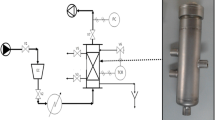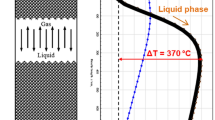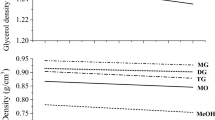Abstract
In order to design industrial scale reactors and proceises for multi-phase biocatalytic reactions, it is essential to understand the mechanisms by which such systems operate. To illustrate how such mechanisms can be modeled, the hydrolysis of the primary ester groups of triglycerides to produce fatty acids and monoglycerides by lipase (glycerol-ester hydrolase) catalysis has been selected as an example of multiphase biocatalysis. Lipase is specific in its behavior such that it can act only on the hydrolyzed (or emulsified) part of the substrate. This follows because the active center of the enzyme is catalytically active only when the substrate contacts it in its hydrolyzed form. In other words, lipase acts only when it can shuttle back and forth between the emulsion phase and the water phase, presumably within an interphase or boundary layer between these two phases. In industrial applications lipase is employed as a fat splitting enzyme to remove fat stains from fabrics, in making cheese, to flavor milk products, and to degrade fats in waste products. Effective use of lipase in these processes requires a fundamental understanding of its kinetic behavior and interactions with substrates under various environmental conditions. Therefore, this study focuses on modeling and simulating the enzymatic activity of the lipase as a step towards the basic understanding of multi-phase biocatalysis processes.
Similar content being viewed by others
Abbreviations
- S1 :
-
Insoluble substrate concentration (mass. volume−1)
- S8 :
-
Soluble substrate concentration (mass. volume1)
- S4 :
-
Substrate saturation concentration (mass volume−1)
- SH :
-
Hydrolyzed substrate concentration (mass. volume−1)
- ST :
-
Total substrate concentration=S1+SH+Ss (mass. volume1)
- E1 :
-
Active enzyme concentration in zone 1 (mass. volume1)
- E2 :
-
Inactive enzyme concentration in zone 2 (mass. volume−1)
- ES:
-
Concentration of enzyme-Substrate complex (mass. volume1)
- P1 :
-
Product concentration in zone 1 (mass. volume1)
- P2 :
-
Product concentration in zone 2 (mass. volume−1)
- PT :
-
Total product concentration =P1+P2 (mass. volume−1)
- D:
-
Dilution rate (time1)
- kL :
-
Liquid phase mass transfer coefficient (time−1)
- k, k1, k2, k3 :
-
Reaction rate constants (time−1)
References
Lilly, M. D. and J. M. Woodley (1985) Biocatalysts in Organic Synthesis J. Tramper, H. C. vander Plas and P. Linko (ed.), P 179–192.
O’Connor, K. and J. E. Bailey (1988) Hydrolysis of emulsified tributyrin by porcine pancreatic lipaseEnzyme Microb. Technol. 10: 352–356.
Brockerhoff, H. and R. G. Jensen (1974) Academic Press, New York, p. 25–90.
Barman, T. E. (1969) Enzyme Handbook. Volume II, Springer-Verlag Inc., New York, p. 503–504.
Ollis, D. F. (1983) Foundations of Biochemical Eng., Kinetics and Thermodynamics of Biological Systems, ACS Symposium Series, No. 207, p. 27–52.
Sarda, L. and P. Desnuelle (1958)Biochim. Biophys. Acta., 30: 513.
Perry, R. H. and D. Green (1984) Chemical Engineer’s Handbook 6th ed. McGraw-Hill Inc., p. 4. 42–43.
Weinstein, H. and R. J. Adler (1967)Chem. Eng. Sci., vol. 22: 65–75.
Levenspiel, O. (1972) Chemical Reaction Engineering 2nd ed. John Wiley and Sons Inc.
Tanner, R. D., I. J. Dunn, J. R. Bourne, and M. K. Klu (1985) The Effect of Imperfect Mixing on an Idealized Kinetic Fermentation ModelChem. Eng. Sci. 40: 1213–1219.
Author information
Authors and Affiliations
Rights and permissions
About this article
Cite this article
Demirer, G.N., Duran, M. & Tanner, R.D. Modeling the catalytic activity and kinetics of lipase (glycerol-ester hydrolase). Biotechnol. Bioprocess Eng. 1, 46–50 (1996). https://doi.org/10.1007/BF02949144
Issue Date:
DOI: https://doi.org/10.1007/BF02949144




